When a car falls into your lap
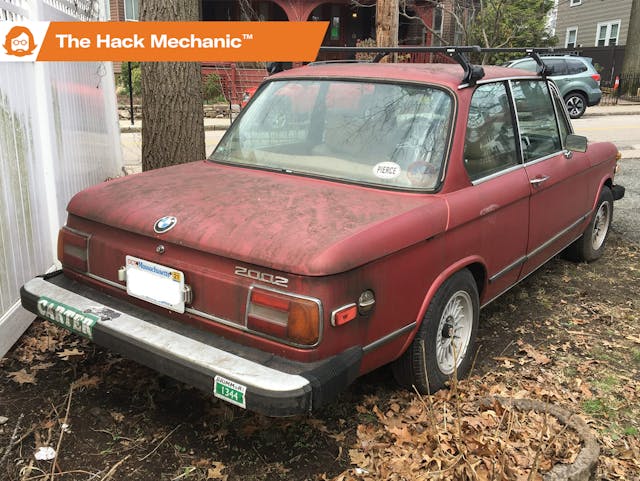
It’s hard to believe it was just a few weeks ago that I wrote my “Why do we keep buying the same car over and over?” piece. In it, I described having owned 40 BMW 2002s over the last four decades, owning three of them now, and finding it difficult to break out of my comfort zone and buy any of the other cars I keep having mental dalliances with.
Having said that, I have to admit something. And it’s a little embarrassing.
I bought another 2002.
Really, I had very little choice.
I’ve long described how my car-buying habits are based on committing crimes of opportunity. That is, I never decide “I’m going to buy X,” then go out and find the best example of X I can find and pay market price for it. Rather, I always seem to default to a) my bottom-feeding habits of preferring affordable needy cars that seem to also need me, and b) finding cars that are close enough for me to look at with my own eyes and drag home with my own truck.
I’ve also long said that there’s something of an imperative in these crimes of opportunity—that is, if The Automotive Powers That Be see fit to drop cars in your lap, you need to be responsive, because if you’re not, TAPTB may well say, “Well, we were going to dangle that rust-free Series 1 E-Type in front of him for $5300, but he didn’t bite on the 2002, so to hell with him.”
So, when a friend of mine contacted me and said that he knew a guy with a 1976 BMW 2002 sitting in his yard that he was looking to sell, and I learned that this fellow lived only one town over from me, I was honor-bound as a car person to follow up on it to learn what it was. Usually these things turn out to be a pile of rusty junk, but you never know unless you set eyeballs on it.
The seller—Seth—and I swapped a few texts, then a phone call. He said that the car had been brought to the East Coast from California six years ago, was kept outside but wasn’t driven during New England winters, had had some rust abatement work done, was essentially rust-free save a few blisters forming on one rocker panel, and ran great until it was parked about nine months ago due to a dead battery. Seth said he’d taken out the battery to get it tested and had left it by the car, and surprisingly, someone had walked off with it. He said he was certain that, with a charged battery dropped in, the car would start right up.
“Are you looking for my advice on valuing it, my help getting it ready for sale, or are you looking to sell it outright?” I asked.
Seth answered “Sell it outright” almost before I’d completed the sentence. He explained that, in three weeks, he and his wife were kicking off a project to build a second house on part of the property, and the car was sitting at what was about to be ground zero. He then named a number he’d sell the 2002 for. If everything he said about the car was accurate, it was pretty close to a drop-everything price.
Let me say that, in the car-buying world, there are few situations more desirable than being the only one who knows about a car that a seller is looking to unload quickly at a bargain price. But while it means that there aren’t thousands of other eyeballs on the car and no one else is bidding against you, that situation can change in a New York minute, and you’re an idiot if you think you have time to dilly-dally. I told Seth I was quite interested, but heavy rain was forecast for the next few days. Seth told me the address where the car was, said he worked about a hundred yards away, and that I could come and see it anytime. I told him I’d get back to him quickly.
I jumped onto Google Maps, punched in the address, and switched to Street View. I moved up and down the street, rotated the view around a bit, and bam, there was the car. While the resolution was low, it clearly showed an intact, red, big-bumpered square-tail-light BMW 2002. I could make out a Thule roof rack, an aftermarket steering wheel, and what looked like turbine-style finned alloy wheels off a late ’70s 320i. These wheels bear enough of a resemblance to the far-rarer Alpina finned alloys that they’re often incorrectly advertised as Alpinas. Unfortunately, it looked like the car was sitting on dirt and gravel, so jacking it up and setting it on stands to look for undercarriage rust would require bringing metal plates and would be a messy operation if it was raining.

My wife, Maire Anne, came into the room and looked at the computer screen. “Another 2002?” she asked. I began explaining the story, but the way that it came out was that I didn’t want to look at it until it stopped raining. She practically laughed in my face.
“Man,” she said. “You are getting soft.”
Her good-natured teasing was an excellent reminder that opportunities like this can evaporate quickly. I contacted Seth and arranged to see the car after lunch. I loaded a fresh battery, tools, floor jack, stands, and metal plates into my car and drove the eight miles to the tony Boston suburb of Brookline. As it happened, the weather cleared. I stopped at Seth’s business so he could give me the key, then continued on to the car.
As I approached it, I could see that the car was a mess, wearing the nine months it sat outside on its sleeve. The red paint was filthy and oxidized. Both the registration and the inspection stickers were expired. And the presence of an unfortunate aftermarket sunroof knocked its desirability down a couple of pegs further.

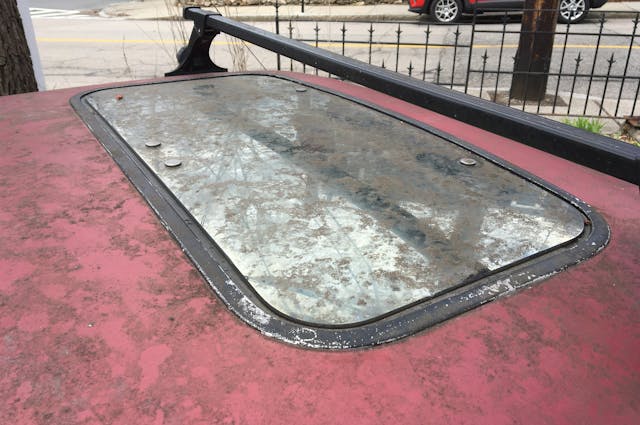
Just when my first impressions were slotting into the “Well, that was a waste of time” category (which, of course, describes most outings to look at cheap cars), my eye was drawn to the wheels, and I realized something: They weren’t 320i “turbine” wheels. They were real 13-inch Alpinas, worth a good portion of the asking price of the car. They cancelled out the aftermarket sunroof with some money left over for tacos. Things were looking up.

A quick walk-around revealed no outer-body rust. I donned my Tyvec suit to do the rocker-and-lower-fender-inspection crawl. As Seth said, there were a couple of rust blisters forming on one rocker panel, but that was about it. Both the softness of the ground and a slight incline made me uncomfortable about jacking the car up, so instead I skooched under as far as I could and looked as best as I could at the floor pans and frame rails. I did not see any rust perforations. And I had to smile at what appeared to be an original “Carter” bumper sticker from the 1976 presidential campaign.

Hmmmmm.
I then looked inside. The interior was a little bipolar. On the one hand, the seats were in excellent condition, but there were leaves and trash everywhere, along with a strong smell of moisture. I looked in the back of the car and saw that there was a couple of inches of water on the floor, likely caused by leaks from The Sunroof of Ill Repute.
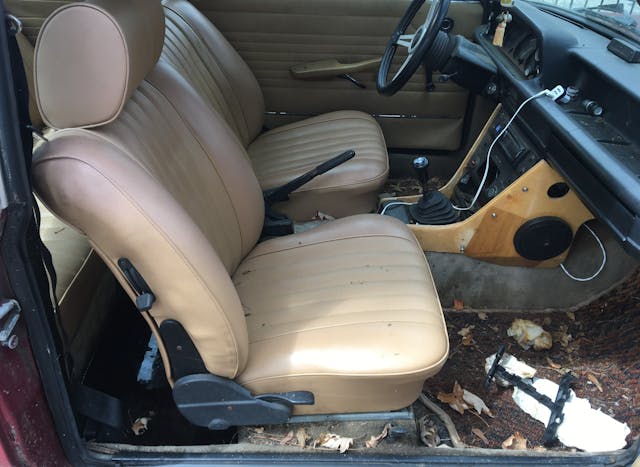

Having gotten a bead on both the exterior and interior, the next thing to do was to test Seth’s “it ran great nine months ago” story. Had the car been sitting for years, the responsible thing to do would’ve been to change the oil and drain and clean the entire fuel delivery system, but nine months isn’t that long for a car to sit. I checked to make sure that the oil looked clean, opened the gas tank and verified that it didn’t smell like varnish, cleaned the battery terminals, dropped in my battery, cranked the starter a few times with the coil disconnected to get oil flowing, then gave it a blast of starting fluid. The car fired up quickly and settled into an even idle. The exhaust appeared smoke-free.
Seth had offered that I was free to drive the car, but the expired stickers gave me pause. Instead, I moved it back and forth three feet in the driveway. By verifying that the clutch and brakes worked, this was all I really needed to know in terms of getting it onto a flatbed.
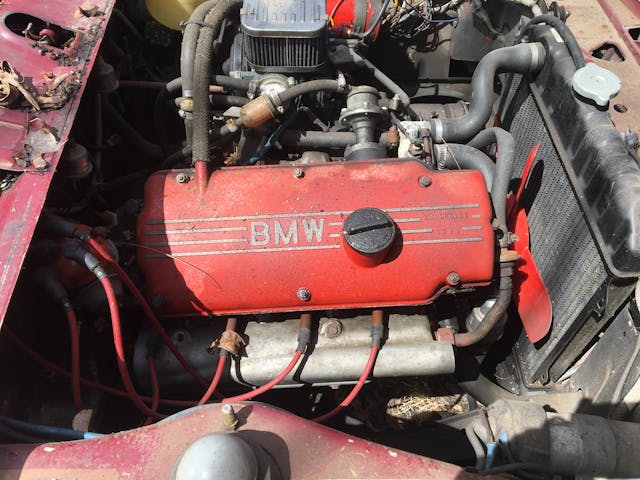
Well, then.
During the time I was poking and prodding the car, two passers-by stopped and chatted with me. Both lived nearby. Both had seen the nine-month-dormant 2002. Both said they always wanted one, had been curious about this one, and were envious that I somehow had gotten to do the secret handshake with the owner. While I didn’t explain that “I’m deciding whether or not to buy it,” it was pretty clear what was up. It made me realize how tenuous the car’s “I’m the only one who knows about it” status was. One of these guys could easily knock on the seller’s door, say “I didn’t realize you were selling that 2002; what do you want for it?” and suddenly my advantage would be gone.
I began thinking a surprising thought—I’m totally going to buy this car. Right now. Yeah, the last thing I need is a fourth 2002, but I’ve long been interested in doing an M20 engine conversion (installing the six-cylinder 168-hp motor from a late 1980s E30 3 Series car), but doing it often requires some cutting, so you need to find a Goldilocks car that’s not so nice that you hate to cut it, but not so ratty that it’s not worth the effort. This, I thought, could be it.
I went back to Seth’s office and returned the key. A combination of the way I’m wired and the way I was raised makes me so honest with people during car negotiations that I’ll often undercut my own position, but it’s how I like to go through this world. I told Seth that, even the Alpina wheels notwithstanding, if he put a battery in the car, cleaned it, dealt with the water on the back floor, and addressed the expired stickers, it was worth two-to-three times what he was asking for it. But if he was offering it to me for X, I had X in my pocket.
His response was to wordlessly slide the key across the table to me.
“Are you sure?” I asked.
“I’m crazy busy preparing for this construction project,” he said. “I don’t have time to deal with people. Yes, I’m sure.” He dug out the title and we passed papers. I asked him about the expired registration tag. “I must’ve misplaced the sticker,” he said. “The car is insured and registered. You’re more than welcome to drive it home on my insurance and plates. You can even leave it here for a few weeks. Just as long as it’s gone by the first of the month.” I said I’d probably move it in the next few days, but I needed to deal with some space issues at my house first.
We walked back outside, Seth removed a few items from the trunk and glove box and said his goodbyes to the car. Then he told me, “The car’s name is Raspberry,” referring to the Granatrot (metallic) red paint that covered its original SienaBraun finish. I nodded, but thought, “Yeah, I’m never going to call it that. Its name is clearly printed on its rear bumper.”
As I described here, I was in the middle of moving cars from my old storage spaces in Fitchburg, Massachusetts, to new warehouse space on the MA-CT border. Since four extra cars were currently taking up every inch of asphalt on my driveway, I had zero room for newly acquired Carter. I corralled my wife and two friends and moved three of the cars to their new home.
With space freed up, I planned how to, ahem, Get Carter (what, you didn’t think I was going to use that?). I could rent a U-Haul transport and tow it home with my truck. Hell, with it only eight miles from my house, I could use my Hagerty or AAA benefit and have it towed for free. But because everything else Seth had said about the car appeared to be accurate, the idea that the car “ran great”—and thus I could simply drive it home—became an intoxicating one. I put the car on my Hagerty policy ($40 for the year … I LOVE you folks!) and got the new plates from the Massachusetts registry just to be absolutely certain about its legality.
The next evening, I had my wife drive me over to Brookline. I brought not only the battery but also an inverter and a small portable sump pump and used it to pump the water out of the back floor so it wouldn’t slosh forward (the video can be seen here). I then inched the car out onto the street and pointed it home.
It was quickly obvious that this was a bad idea. The car ran and rode horribly. What in the driveway had been a smooth idle became a labored rattly cacophony whenever I tried to cross 2500 rpm. There was so much clattering that I wondered if I was hearing a rod knock. Suspension and steering-wise, there was a loud bang coming from the right front. I wondered if the ball joint was bad. I made it home by the skin of my teeth. The back end of the car was raising a racket over bumps as well. My steal of a buy suddenly seemed closer to market value for a barely running car. On the other hand, if it really did have engine damage, it paved the way for that M20 engine conversion, right? And if it did die on the eight-mile drive home, a cell phone and a call to Hagerty Roadside Assistance would produce a tow truck. But I made it.
The next morning, I washed the layer of grime off the car, soaked up the rest of the water from the rug with a chamois, and vacuumed the interior. Carter was suddenly presentable.

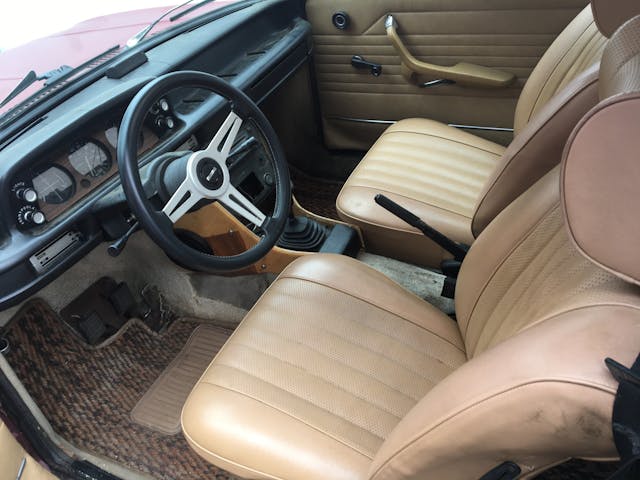
As I was about to leave for a week-long road trip in my 2002tii—the one I’d just replaced the head on—to the “MidAmerica 02Fest” in Eureka Springs, Arkansas, I was hyper-aware that I couldn’t spend too much time sorting out Carter. But I did want to get to the point where I’d wrapped my head around what it was I’d actually bought.
My main point of concern was all that clattering from the engine. Fortunately, much of it was traceable to an unsecured battery clamp and a loose smog pump. With those tightened down, hunting with a mechanic’s stethoscope revealed only a bit of timing chain clatter. The clunking from the back end of the car was due to old rubber bushings at the tops of the rear shocks, easily remedied. What sounded like a bad right front ball joint turned out to be a bad bearing in the front strut tower bushing. With some care, I was able to replace it without having to remove the strut assembly from the car. The car’s generally poor running seemed to lessen quite a bit over time. I ran ever-widening circles around the block. A highway drive would have to wait for new 185/70/13 tires to replace the 15-year-old cracked ones that were mounted on the Alpinas.

It’s a bit soon to say whether the future will really hold an M20 engine swap for Carter. I have to admit, with the car whole, intact, and running, and with all the expenses from the other cars, it’s tempting to re-home it with one of the many people who contact me saying, “If you ever find a 2002 you don’t want to keep …”
But at least I passed the “react appropriately when a car falls into your lap” test. And that’s the important part. So, Automotive Powers That Be, feel free to dangle that E-Type. I have proven myself worthy.
***
Rob Siegel’s latest book, The Best of the Hack MechanicTM: 35 years of hacks, kluges, and assorted automotive mayhem, is available on Amazon. His other seven books are available here, or you can order personally inscribed copies through his website, www.robsiegel.com.

